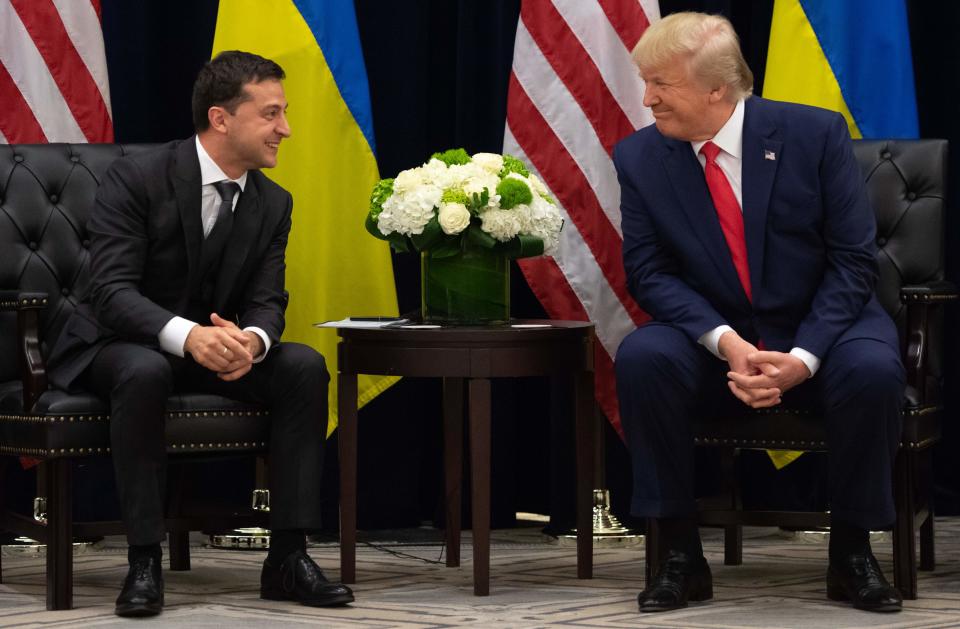From a 'perfect' call to a party switch: How we got to the impeachment of Donald Trump

WASHINGTON – It was July 24 and special counsel Robert Mueller was testifying before a national TV audience to the House Intelligence Committee about his investigation into the Russian interference in the 2016 election and potential coordination with the Trump campaign.
President Donald Trump watched intently as Republican lawmakers went after Mueller, whose stoic and, at times, uneven performance seemed to please the man at the center of the inquiry.
“This was a devastating day for the Democrats,” Trump told reporters later that day.
Feeling vindicated, the president derided the special counsel's presentation during a phone call with Ukraine President Volodymyr Zelensky the following day, July 25.
"As you saw yesterday, that whole nonsense ended with a very poor performance by a man named Robert Mueller, an incompetent performance, but they say a lot of it started with Ukraine," the president told Zelensky. "Whatever you can do, it’s very important that you do it if that’s possible."
USA TODAY Poll: Impeached or not, Trump leads his Democratic rivals for another term
"It" was Trump's request that Ukraine look into Crowdstrike, the California-based tech company that first connected the 2016 hacking of the Democratic National Committee to Russia.
Later in the conversation, Trump asked Zelensky to "look into" the role then-Vice President Joe Biden played in stopping a prosecution of an oligarch behind a Ukrainian energy company that had ties to Biden's son, Hunter.

The call set off a chain of events that led to the House Judiciary Committee last week voting to send two articles of impeachment – for abuse of power and obstruction of Congress – to the floor for a vote by the full House.
Here's a look at key dates along the impeachment path:
July 25: In the call with Zelensky, Trump asks the Ukrainian president "to do us a favor" by investigating both Crowdstrike and the role of Biden and his son, Hunter, whose appointment to the board of a Ukraine energy company, Burisma, had been the subject of a corruption allegation in the Eastern European country. Details of the call, which Trump often describes as "perfect," would not become public for nearly two months.
Aug 12: An anonymous whistleblower who spoke to aides who listened to the call files a report about the July 25 call.
After the whistleblower's complaint, the inspector general for the intelligence community, Michael Atkinson, found it credible and urgent, the threshold necessary to inform lawmakers. The complaint is not released until Sept. 26.
Sept. 24: Pelosi launches the impeachment inquiry, a few days after a Wall Street Journal article revealing the Zelensky phone call.
Details emerge that the White House was holding up nearly $400 million in congressional-approved military aid for Ukraine, an ally, as well as a White House meeting with Trump unless Zelensky agreed to announce an investigation into both Crowdstrike and the Bidens.
The investigation of Biden, who is leading polls in the Democratic race to challenge Trump next year, becomes the driving narrative for Democrats who say Trump must be impeached to prevent him from pressuring a foreign government for political benefit in the 2020 election.
Sept. 25: The White House releases a summary of the July 25 phone call between Trump and Zelensky.
Oct. 13: Former U.S. special envoy to Ukraine Kurt Volker is the first of what would end up being more than a dozen witnesses called before a trio of House committees and questioned for hours behind closed doors about Trump and Ukraine.
Keep informed: How to stay updated on USA TODAY's impeachment coverage
Oct. 31: By a 232-196 margin, the House passes a resolution formalizing the impeachment inquiry almost entirely along party lines. Only two Democrats – Collin Peterson of Minnesota and Jeff Van Drew of New Jersey – vote against the measure.
Within weeks, Van Drew signals that he is switching to the GOP over impeachment.
Nov. 13: The first open hearings begin before the Intelligence Committee with Ambassador William Taylor and Deputy Assistant Secretary George Kent. Over the next 10 days, about a dozen witnesses testify on various aspects of the Ukraine situation. The consensus is that Russia – not Ukraine – was behind the interference of the 2016 U.S. election.
The most dramatic testimony came from Gordon Sondland, Trump's ambassador to the European Union, who said many top administration officials understood the president's desire for a quid pro quo where the military aid and the White House meeting were conditioned on an announcement of an investigation into the Bidens.
“Everyone was in the loop,” Sondland told the committee.
Dec. 13: House Judiciary Committee votes along party lines to impeach Trump on two articles, abuse of power and obstruction of Congress, sending the two issues to the full House for a vote. The vote comes a day after the White House releases a memo saying the delay in sending the aid to Ukraine was to make sure the money was being spent "prudently," not for political reasons.
Dec. 18: The full House begins debate on both impeachment articles Wednesday. If either passes, the Senate must hold a trial. If Trump is convicted, he would be removed from office.
Senate Majority Leader Mitch McConnell, R-Ky., has said the Senate will not vote to remove the president and that he'll be in "total coordination" with the White House if impeachment advances to his chamber.
This article originally appeared on USA TODAY: Trump impeachment: Zelensky call, whistleblower started path to vote